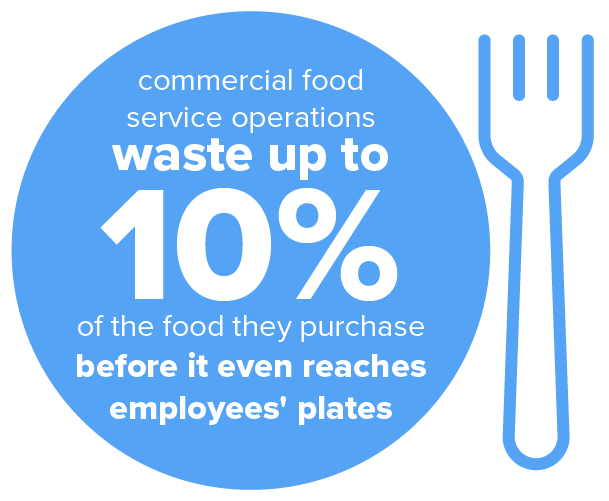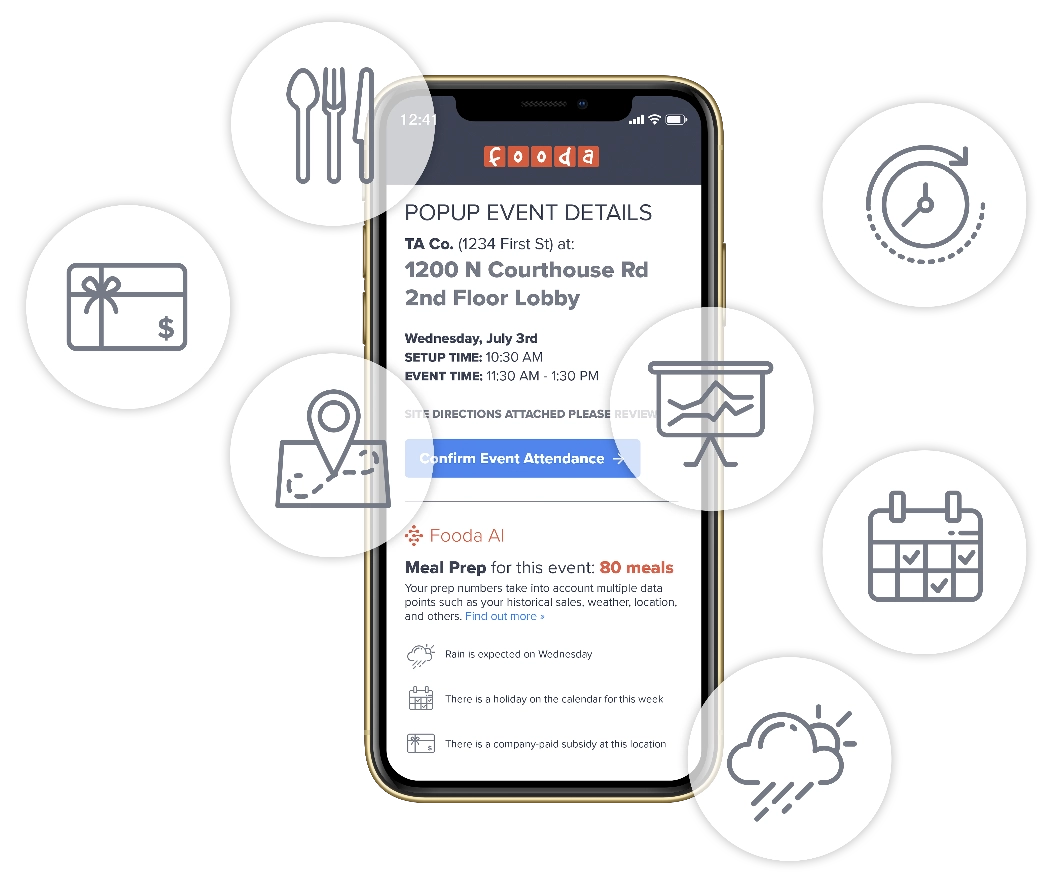

Could you be giving $50,000 back to your company by reducing food waste?
For a mid-sized company spending ~$500,000 annually on employee dining, wasting the average of 4-10% of the food budget means up to ~$50,000 thrown away each year, not even including disposal costs.
That represents a significant financial drain impacting your bottom line, sustainability goals, and company culture. Not to mention, commercial food service operations waste up to 10% of the food they purchase before it even reaches employees' plates, translating to nearly 12.7 million tons of surplus food annually from the food service sector alone. Phew!
So, when you actively reduce food waste in your corporate cafeteria, you're maximizing ROI, meeting ESG commitments, and building a sustainable workplace culture that employees can be proud of.
And the better news? It’s not complicated to implement solutions. With the right strategies, partners, approach, organizations can dramatically cut waste while reducing food costs.
Keep reading to learn about proven food waste reduction strategies and how innovative dining options are improving the planet and the office lunch experience.
Before implementing any solutions, it's important to fully understand the scope and sources of food waste in workplace settings. The current statistics are honestly shocking, but they also represent a massive opportunity for improvement in waste management (and your bottom line).

Corporate dining facilities remain a major contributor to the 66 million tons of wasted food created annually in the United States alone. For corporate cafeterias specifically, the challenge is compounded by unpredictable attendance patterns in today's hybrid work environment.
When food waste ends up in landfills, it decomposes and releases methane, a greenhouse gas 28 times more potent than carbon dioxide. This isn’t even accounting for the waste of what was put into growing, processing, and transporting the food that ends up in the trash.
Suddenly, a nice perk for your employees starts to become a liability for the planet.
Understanding where food waste comes from is the first step toward reducing it. In corporate dining settings, waste typically comes from four main sources:
The design of conventional corporate cafeterias makes waste reduction particularly challenging... Traditional models operate on fixed production schedules that assume consistent demand, but our modern work patterns create highly variable attendance.
This is especially true with hybrid arrangements where you’re never sure who is on-site today or working from home. A cafeteria might prepare for 200 employees on a Tuesday when only 120 show up to the office.
On top of that, limited menu flexibility for corporations just further compounds the problem. When cafeterias serve the same rotating menu week after week, employees will often lose interest and just stop purchasing meals, leading to increased and unpredictable waste.
Bulk purchasing doesn’t help either, as minimum requirements force companies to buy large quantities to achieve a lower cost, but this often leads to spoilage that ends up negating those savings.

While reducing food waste aligns with environmental values, the financial benefits provide equally compelling reasons to prioritize waste reduction in your corporate dining program.

The most immediate benefit of reducing food waste is cost savings. Companies that implement comprehensive waste reduction strategies typically see 20-60% reductions in food costs within the first year.
For a mid-sized company spending $500,000 annually on employee dining, that could mean recovering up to $300,000 that was previously lost to waste. Beyond direct food costs, waste reduction improves ROI on employee dining programs and reduces disposal expenses.

For companies committed to sustainability and ESG principles, reducing food waste represents low-hanging fruit with measurable impact. Every ton of food waste diverted from landfills prevents approximately 0.5 tons of CO2-equivalent greenhouse gas emissions.
Supporting sustainable corporate dining practices also strengthens relationships with local suppliers and communities (and it’s something to boast about to potential investors and candidates).

How a company handles food waste sends a powerful message about its values to all the community, employees, and stakeholders.
Studies show that employees want to work for organizations that demonstrate genuine commitment to sustainability. With 68% of people being more willing to seek out and accept positions from environmentally sustainable companies.
Attention to sustainability is particularly important among younger generations, who prioritize environmental and social impact in their career decisions. Plus, visible efforts to reduce cafeteria waste reduction show that leadership takes these values seriously. This often creates opportunities for participation and ownership, which helps to build an earth-conscience company culture.
Understanding the problem is one thing, solving it is another. Here are six proven strategies that businesses can implement in order to substantially reduce food waste in their workplace dining programs:

You can't manage what you don't measure. A comprehensive food waste audit can provide the baseline data needed to identify problems and track improvement.
Document all food waste over a two-week period, separating waste by category: pre-consumer waste (spoilage, preparation waste), post-consumer waste (plate waste), and unavoidable waste (bones, peels, shells).
If you can, track what's being wasted and why. Then use this data to inform purchasing decisions and adjust production quantities. Many companies end up discovering that just 20% of menu items account for 80% of waste.
Implement data-driven ordering based on actual consumption patterns rather than just assumptions. Use FIFO (first-in, first-out) inventory rotation by labeling all items with receive dates and ensuring older stock gets used before newer deliveries.
Avoid overstocking perishables by ordering smaller quantities more frequently. While this may slightly increase per-unit costs, the reduction in spoilage typically delivers net savings.
Offering flexible portion options empowers employees to take only what they'll eat. You can offer small, regular, and large portions for main dishes, as research shows this simple change can reduce plate waste by 20-30%.
Also consider your plating options; using smaller plates creates an effect that helps employees feel satisfied with appropriate portions. You can also design menus around ingredients that can be used across multiple dishes, reducing the risk of spoilage.
Consider also rotating menus regularly to keep employees engaged and to reduce menu fatigue.
Modern technology offers powerful tools for predicting demand and optimizing operations.
Smart ordering platforms use historical data, attendance patterns, and even weather forecasts to predict daily demand with remarkable accuracy. Real-time analytics monitor consumption patterns and provide actionable insights about which menu items consistently sell out and which generate waste.
When you use a pre-ordering system, it eliminates overproduction by ensuring food is prepared only for employees who have committed to purchasing it. It’s a win-win for your team and the planet.
Technology and systems are important, but thoughtful employee behavior also determines success. Here are some ideas you can implement at your workplace:

Not all food waste can be prevented, but it doesn't have to go to landfills. So where are the best places to send it?
Both of these options help the community and the environment while reducing overall food waste for your organization.
While the strategies above can significantly reduce food waste in corporate cafeterias and dining programs, some companies are discovering that the most effective approach is reimagining corporate dining entirely.
Innovative companies like Fooda address the root causes of food waste through their tech-forward model.

Unlike traditional cafeterias that prepare food in advance based on estimates, Fooda's on-demand approach means restaurants prepare meals based on actual pre-orders.
There's no overproduction because there's no guesswork, employees can pre-order their meals, and restaurants prepare exactly what's been ordered. This flexible scheduling naturally matches office attendance patterns, scaling up or down based on actual demand.

Fooda's technology uses smart scheduling based on employee ordering behavior. By analyzing patterns over time, the system identifies which types of cuisine and which specific restaurants generate the most engagement.
Without long-term inventory requirements or on-site storage needs, Fooda's cafeteria solutions for corporate dining eliminate spoilage concerns entirely.

Fooda's model inherently supports sustainability through local sourcing. By partnering with local restaurants, the platform reduces transportation emissions compared to traditional food service operations. These restaurants also typically use fresh ingredients with shorter supply chains, further reducing environmental impact.
The rotating lineup of local restaurants solves the menu fatigue problem that plagues traditional cafeteria models, increasing employee satisfaction and reducing waste.
Reducing food waste doesn't mean compromising on quality, variety, or employee satisfaction. With the right approach, you can cut waste, reduce costs, and create a dining program that employees genuinely love.
Fooda's innovative platform naturally minimizes waste while delivering restaurant-quality meals from local favorites. Our data-driven, on-demand model scales with your actual needs, eliminating overproduction and aligning perfectly with today's hybrid work patterns.
Want to see how Fooda can help your organization reduce food waste while improving your employee dining experience and bottom line? Schedule a conversation with our team today.
Hybrid work creates variable attendance patterns that make demand forecasting difficult. Pre-ordering systems and flexible scheduling are essential for minimizing waste in hybrid environments.
Most companies see 20-50% reductions in food costs within the first year of implementing comprehensive waste reduction strategies.